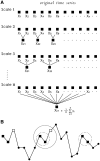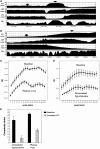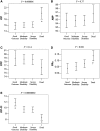Complexity of intracranial pressure correlates with outcome after traumatic brain injury
- PMID: 22734128
- PMCID: PMC3407422
- DOI: 10.1093/brain/aws155
Complexity of intracranial pressure correlates with outcome after traumatic brain injury
Abstract
This study applied multiscale entropy analysis to investigate the correlation between the complexity of intracranial pressure waveform and outcome after traumatic brain injury. Intracranial pressure and arterial blood pressure waveforms were low-pass filtered to remove the respiratory and pulse components and then processed using a multiscale entropy algorithm to produce a complexity index. We identified significant differences across groups classified by the Glasgow Outcome Scale in intracranial pressure, pressure-reactivity index and complexity index of intracranial pressure (P < 0.0001; P = 0.001; P < 0.0001, respectively). Outcome was dichotomized as survival/death and also as favourable/unfavourable. The complexity index of intracranial pressure achieved the strongest statistical significance (F = 28.7; P < 0.0001 and F = 17.21; P < 0.0001, respectively) and was identified as a significant independent predictor of mortality and favourable outcome in a multivariable logistic regression model (P < 0.0001). The results of this study suggest that complexity of intracranial pressure assessed by multiscale entropy was significantly associated with outcome in patients with brain injury.
Figures




Similar articles
-
Effects and Clinical Characteristics of Intracranial Pressure Monitoring-Targeted Management for Subsets of Traumatic Brain Injury: An Observational Multicenter Study.Crit Care Med. 2015 Jul;43(7):1405-14. doi: 10.1097/CCM.0000000000000965. Crit Care Med. 2015. PMID: 25803654
-
Cerebrovascular Pressure Reactivity in Children With Traumatic Brain Injury.Pediatr Crit Care Med. 2015 Oct;16(8):739-49. doi: 10.1097/PCC.0000000000000471. Pediatr Crit Care Med. 2015. PMID: 26132743
-
Autonomic Impairment in Severe Traumatic Brain Injury: A Multimodal Neuromonitoring Study.Crit Care Med. 2016 Jun;44(6):1173-81. doi: 10.1097/CCM.0000000000001624. Crit Care Med. 2016. PMID: 26968025
-
Factors influencing intracranial pressure monitoring guideline compliance and outcome after severe traumatic brain injury.Crit Care Med. 2012 Jun;40(6):1914-22. doi: 10.1097/CCM.0b013e3182474bde. Crit Care Med. 2012. PMID: 22488001
-
[Value of serial CT scanning and intracranial pressure monitoring for detecting new intracranial mass effect in severe head injury patients showing lesions type I-II in the initial CT scan].Neurocirugia (Astur). 2005 Jun;16(3):217-34. Neurocirugia (Astur). 2005. PMID: 16007322 Review. Spanish.
Cited by
-
Assessing rheoencephalography dynamics through analysis of the interactions among brain and cardiac networks during general anesthesia.Front Netw Physiol. 2022 Aug 29;2:912733. doi: 10.3389/fnetp.2022.912733. eCollection 2022. Front Netw Physiol. 2022. PMID: 36926077 Free PMC article.
-
Prehospital Intubation and Outcome in Traumatic Brain Injury-Assessing Intervention Efficacy in a Modern Trauma Cohort.Front Neurol. 2018 Apr 10;9:194. doi: 10.3389/fneur.2018.00194. eCollection 2018. Front Neurol. 2018. PMID: 29692755 Free PMC article.
-
Characterisation of the complexity of intracranial pressure signals measured from idiopathic and secondary normal pressure hydrocephalus patients.Healthc Technol Lett. 2016 Jul 5;3(3):226-229. doi: 10.1049/htl.2016.0018. eCollection 2016 Sep. Healthc Technol Lett. 2016. PMID: 27733932 Free PMC article.
-
A Detailed Protocol for Physiological Parameters Acquisition and Analysis in Neurosurgical Critical Patients.J Vis Exp. 2017 Oct 17;(128):56388. doi: 10.3791/56388. J Vis Exp. 2017. PMID: 29155778 Free PMC article.
-
Blood Pressure Complexity Discriminates Pathological Beat-to-Beat Variability as a Marker of Vascular Aging.J Am Heart Assoc. 2022 Feb;11(3):e022865. doi: 10.1161/JAHA.121.022865. Epub 2022 Jan 19. J Am Heart Assoc. 2022. PMID: 35043657 Free PMC article.
References
-
- Angelini L, Maestri R, Marinazzo D, Nitti L, Pellicoro M, Pinna GD, et al. Multiscale analysis of short term heart beat interval, arterial blood pressure, and instantaneous lung volume time series. Artif Intell Med. 2007;41:237–50. - PubMed
-
- Aries MJH, Czosnyka M, Budohoski K, Steiner L, Lavinio A, Kolias A, et al. Continuous determination of optimal cerebral perfusion pressure in traumatic brain injury. Crit Care Med. 2012 Advance Access published on May 2, 2012, doi: 10.1097/CCM.0b013e3182514eb6. - PubMed
-
- Auer LM, Sayama I. Intracranial pressure oscillations (B-waves) caused by oscillations in cerebrovascular volume. Acta Neurochir (Wien) 1983;68:93–100. - PubMed
-
- Balestreri M, Czosnyka M, Hutchinson P, Steiner LA, Hiler M, Smielewski P, et al. Impact of intracranial pressure and cerebral perfusion pressure on severe disability and mortality after head injury. Neurocrit Care. 2006;4:8–13. - PubMed
-
- Balestreri M, Czosnyka M, Steiner LA, Hiler M, Schmidt EA, Matta B, et al. Association between outcome, cerebral pressure reactivity and slow ICP waves following head injury. Acta Neurochir Suppl. 2005;95:25–8. - PubMed

